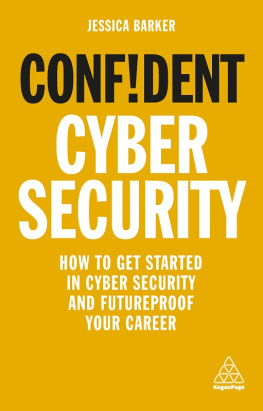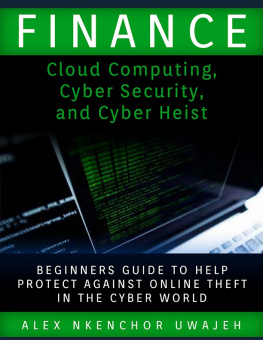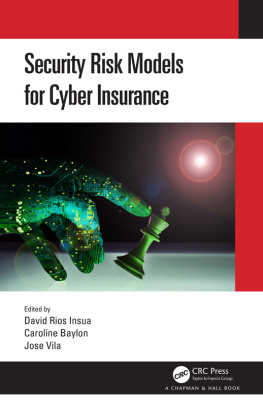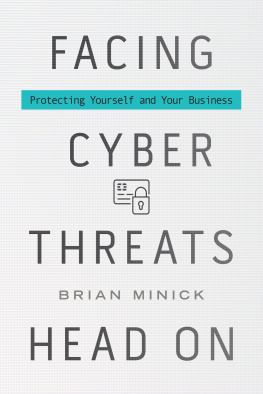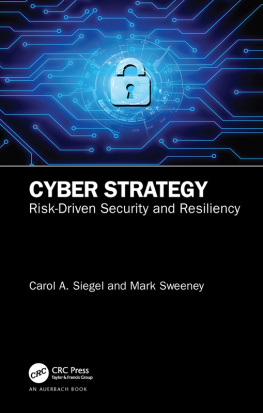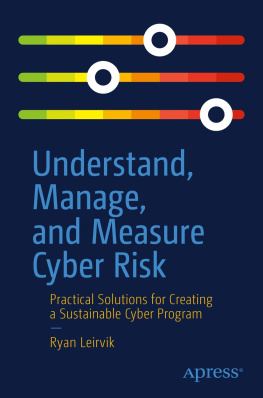
Table of Contents
List of Tables
- Chapter 01
- Chapter 02
- Chapter 03
- Chapter 04
- Chapter 05
- Chapter 06
- Chapter 07
- Chapter 08
- Chapter 09
- Chapter 10
List of Illustrations
- Preface
- Chapter 01
- Chapter 02
- Chapter 03
- Chapter 04
- Chapter 05
- Chapter 06
- Chapter 07
- Chapter 08
- Chapter 09
- Chapter 10
Guide
Pages
ABOUT THE COMPANION WEBSITE
This book is accompanied by a companion website:
www.wiley.com/go/sahinoglu/informatics
The website includes:
- Solutions manual available to students
- PowerPoint slides available to instructors
CYBER-RISK INFORMATICS
Engineering Evaluation with Data Science
MEHMET SAHINOGLU, PH.D.
Auburn University at Montgomery
Copyright 2016 by John Wiley & Sons, Inc. All rights reserved
Published by John Wiley & Sons, Inc., Hoboken, New Jersey
Published simultaneously in Canada
No part of this publication may be reproduced, stored in a retrieval system, or transmitted in any form or by any means, electronic, mechanical, photocopying, recording, scanning, or otherwise, except as permitted under Section 107 or 108 of the 1976 United States Copyright Act, without either the prior written permission of the Publisher, or authorization through payment of the appropriate per-copy fee to the Copyright Clearance Center, Inc., 222 Rosewood Drive, Danvers, MA 01923, (978) 750-8400, fax (978) 750-4470, or on the web at www.copyright.com. Requests to the Publisher for permission should be addressed to the Permissions Department, John Wiley & Sons, Inc., 111 River Street, Hoboken, NJ 07030, (201) 748-6011, fax (201) 748-6008, or online at http://www.wiley.com/go/permissions.
Limit of Liability/Disclaimer of Warranty: While the publisher and author have used their best efforts in preparing this book, they make no representations or warranties with respect to the accuracy or completeness of the contents of this book and specifically disclaim any implied warranties of merchantability or fitness for a particular purpose. No warranty may be created or extended by sales representatives or written sales materials.The advice and strategies contained herein may not be suitable for your situation. You should consult with a professional where appropriate. Neither the publisher nor author shall be liable for any loss of profit or any other commercial damages, including but not limited to special, incidental, consequential, or other damages.
For general information on our other products and services or for technical support, please contact our Customer Care Department within the United States at (800) 762-2974, outside the United States at (317) 572-3993 or fax (317) 572-4002.
Wiley also publishes its books in a variety of electronic formats. Some content that appears in print may not be available in electronic formats. For more information about Wiley products, visit our web site at www.wiley.com.
Library of Congress Cataloging-in-Publication Data
Names: Sahinoglu, Mehmet, 1951 author.
Title: Cyber-risk informatics : engineering evaluation with data science / Mehmet Sahinoglu.
Description: Hoboken, New Jersey : John Wiley & Sons, 2016. | Includes bibliographical references and index. | Description based on print version record and CIP data provided by publisher; resource not viewed.
Identifiers: LCCN 2015036259 (print) | LCCN 2015032749 (ebook) | ISBN 9781119087526 (Adobe PDF) | ISBN 9781119087533 (ePub) | ISBN 9781119087519 (cloth)
Subjects: LCSH: Cyber intelligence (Computer security) | Computer systemsReliability. | Computer softwareReliability. | Computer networksSecurity measuresData processing. | Risk assessmentStatistical methods.
Classification: LCC QA76.9.A25 (print) | LCC QA76.9.A25 S2497 2016 (ebook) | DDC 005.8dc23
LC record available at http://lccn.loc.gov/2015036259
ABOUT THE COVER
The multifaceted nature of network security reminds one of the ancient fable, the parable of The Blind Men and the Elephant, where the blind men (or security risk researchers today) are touching the elephant (or network security) to understand what it really is or isnt, because they have never encountered an elephant before. One man touches the elephants tusk, and the other its side, while another touches its tail and yet another its trunk. When they reunite to discuss their findings, they cannot agree what the elephant looks like; such as one thought the trunk was a snake, and the other imagined a tree branch, and so it goes. Much the same happens when it comes to cyber-risk assessment and management. Network security is such a complex, multifaceted topic that cyber-risk specialists are like the veritable blind men grasping at parts and unable to understand the elephant completely. This books intent is to provide a timely remedy to that symbolic elephantine metaphors puzzle by providing a holistic-theoretical and philosophical as well as practical, user-friendly and useful, and application-oriented within a well-grounded holistic approach to network security risk assessment, such that those blind men will no longer be so unfamiliar with the elephant! The universal message here is not seeking total security (a perfect knowledge of the elephant by seeing it, never to happen for the blind men), however focusing on managing the insecurity (understanding the elephant in the best manner that the blind men could), which is what this pioneering textbook is all about.
PROLOGUE
A little neglect may breed great mischief
For want of nail, the shoe was lost;
For want of a shoe, the horse was lost;
And for want of a horse, the rider was lost.
Benjamin Franklin, Poor Richards Almanac 1758
A little lack of countermeasure may breed great breach
For want of firewall, the software was lost;
For want of software, the hardware was lost;
And for want of hardware, the user was lost.
Mehmet Sahinoglu, Cyber-Risk Informatics 2016
REVIEWS
The Cyber-RiskInformatics is a sequel to Dr. Sahinoglus earlier Wiley text of 2007 and is a reinforcement of his popularized risk metric approach to assessing and managing security and reliability of cyber components and networks at large. His Cyber-Risk assurance modeling, employing math statistically sound metric approaches, from Healthcare to Cloud Computing to name a few themes that he has implemented is not to be encountered in todays many case study-based textbooks. I certainly take pride in writing a new foreword this time 8 full years later for his follow-up as I was pleased to personally recommend back in 2011 to prepare a new manuscript to incorporate all of his new findings and journal publications. The inaction of not creating this text otherwise would have left a serious void and waste of resources to reach our new generation of risk (fire) fighters to quench the widely prevalent network (forest) breaches (arsons) as the metaphor goes, if you will.
It is my distinct pleasure to highly recommend this book of multi- and transdisciplinary nature equipped with numerical methods and directly related to software application provided for the readers and students as a gluing medium to synergize all the necessary components of research from Testing to Simulation and from Security Assessment to Cloud Computing and hands-on lab practices. His goal to emphasize the strong link between the academic and corporate worlds that complement one another is well justified. I strongly recommend anyone eager to learn new depths in Cyber-Risk modeling to visit this museum of knowledge that will become a scientific classic to refer to in the decades ahead.



